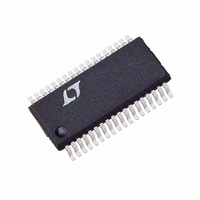LTC4259ACGW Linear Technology, LTC4259ACGW Datasheet - Page 29

LTC4259ACGW
Manufacturer Part Number
LTC4259ACGW
Description
IC CTRLR POE QUAD AC DISC 36SSOP
Manufacturer
Linear Technology
Datasheet
1.LTC4259ACGW.pdf
(32 pages)
Specifications of LTC4259ACGW
Controller Type
Power over Ethernet Controller (POE)
Interface
I²C
Voltage - Supply
3 V ~ 4 V
Current - Supply
2.5mA
Operating Temperature
0°C ~ 70°C
Mounting Type
Surface Mount
Package / Case
36-SSOP
Linear Misc Type
Negative Voltage
Family Name
LTC4259A
Operating Supply Voltage (min)
-48V
Operating Supply Voltage (max)
-57V
Operating Temperature (min)
0C
Operating Temperature (max)
70C
Operating Temperature Classification
Commercial
Mounting
Surface Mount
Pin Count
36
Lead Free Status / RoHS Status
Contains lead / RoHS non-compliant
Available stocks
Company
Part Number
Manufacturer
Quantity
Price
Part Number:
LTC4259ACGW
Manufacturer:
LT/凌特
Quantity:
20 000
Company:
Part Number:
LTC4259ACGW#TR
Manufacturer:
LINEAR
Quantity:
45 308
Company:
Part Number:
LTC4259ACGW#TR
Manufacturer:
ROHM
Quantity:
4 942
Company:
Part Number:
LTC4259ACGW-1
Manufacturer:
LT
Quantity:
39 000
Company:
Part Number:
LTC4259ACGW-1
Manufacturer:
MURATA
Quantity:
3 942
Part Number:
LTC4259ACGW-1
Manufacturer:
LT
Quantity:
20 000
Part Number:
LTC4259ACGW-1#
Manufacturer:
LT
Quantity:
20 000
Part Number:
LTC4259ACGW-1#TRPBF
Manufacturer:
LINEAR/凌特
Quantity:
20 000
APPLICATIO S I FOR ATIO
a current loop can form. In such a loop, common mode
current flows in one port and out the other, and the choke
will not prevent this because the sum of the currents is
zero. Another way to view this interaction between the
paired ports is that the choke acts as a transformer
coupling the ports’ common modes together. In
nonpowered Ethernet, common mode current results
from nonidealities like ground loops; it is not part of
normal operation. However, Power over Ethernet sends
power and hence significant current through the ports;
common mode current is a byproduct of normal opera-
tion. As described in the Choosing External MOSFETs
section and under the Power Supplies heading below,
large transients can occur when a port’s power is turned
on or off. When a powered port is shorted (see Surge
Suppressors and Circuit Protection), a port’s common
mode current may be excessive. Sharing a common mode
choke between two ports couples start-up, disconnect
and fault transients from one port to the other. The end
result can range from momentary noncompliance with
802.3af to intermittent behavior and even to excessive
voltages that may damage circuitry (in both the PSE and
PD) connected to the ports.
Detect, AC Blocking and Transient Suppressor Diodes
During detection and classification, the LTC4259A senses
the port voltage through the detect diodes D
ure 18. Excessive voltage drop across D
the LTC4259A’s detect and classification results. Select a
diode for D
at 0.4mA and less than 0.9V of forward drop at 50mA.
When the port is powered, the detect diode is reverse bi-
ased. Any leakage through the detect diode prevents the
LTC4259A from sensing all the current coupled through the
C
bias, a typical switching diode like the 1N4148 may have
more than 50µA of leakage. Such leakage can interfere with
AC disconnect because it is a large fraction of the
LTC4259A’s I
diode like the CMPD3003 is recommended.
The AC blocking diodes can interfere with AC disconnect
sensing if they become leaky. If the AC blocking diode (D
in Figure 18) begins leaking, it contributes to the Ethernet
DET
capacitor. At high temperature with 70V of reverse
DET
ACDMIN
that will have less than 0.7V of forward drop
U
threshold. Using a low leakage detect
U
W
DET
will corrupt
DET
U
in Fig-
AC
port impedance, potentially bringing the impedance low
enough to draw I
port powered. More likely, leakage through the AC block-
ing diode will cause shifts in the AC disconnect threshold
that are not large enough to make the PSE noncompliant.
Generally, diode leakage is caused by voltage or tempera-
ture stress. Diodes that are rated to 100V or more and can
handle dissipating at least 0.5W should be acceptable in
this application. Other component leakages can have a
similar affect on AC disconnect and even affect DC discon-
nect if the leakage becomes severe. Among components
to be wary of are the transient surge suppressors. The
devices shown in Figure 1 are rated for less than 5µA of
leakage at 58V. However there is a potential for stress
induced leakage, so healthy margins should be used when
selecting diodes for these applications.
Capacitors
Sizing of both the C
proper operation of the LTC4259A’s AC disconnect sens-
ing. See the AC Disconnect section for more information.
Also, C
powered port. Port voltage instability is generally not a
problem if V
of these reasons be aware that many ceramic dielectrics
have dramatic DC voltage and temperature coefficients. A
0.22µF ceramic capacitor is often nowhere near 0.22µF
when operating at 50VDC or 100VDC. Use 100V or higher
rated X7R capacitors for C
duced voltage dependance while also being relatively small
and inexpensive.
Power Supplies
The LTC4259A must be supplied with 3.3V (V
–48V (V
can lead to noncompliance. The IEEE requires a PSE
output voltage between 44V and 57V. When the LTC4259A
begins powering an Ethernet port, it controls the current
through the port to minimize disturbances on V
ever, if the V
unstable, its voltage could go outside of the IEEE specified
limits, causing all ports in the PSE to be noncompliant.
This scenario can be even worse when a PD is unplugged
because the current can drop immediately to zero. In both
PSE
EE
). Poor regulation on either of these supplies
may be important to the voltage stability of a
EE
, the –48V supply, is well bypassed. For both
EE
ACDMIN
supply is underdamped or otherwise
DET
from the DETECT pin and keep the
and C
DET
PSE
and C
capacitors is critical to
PSE
LTC4259A
as these have re-
EE
DD
29
. How-
) and
4259afb













